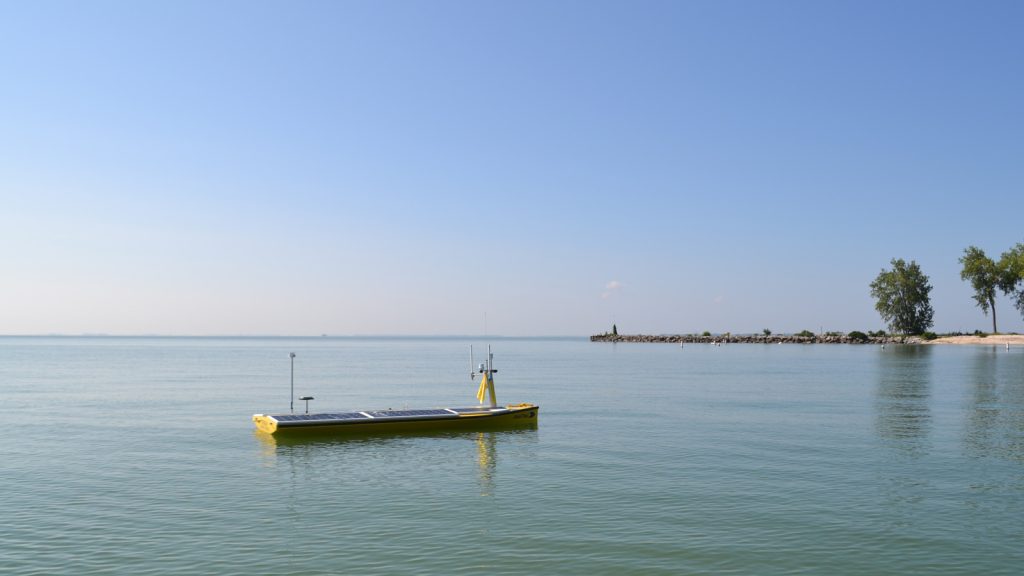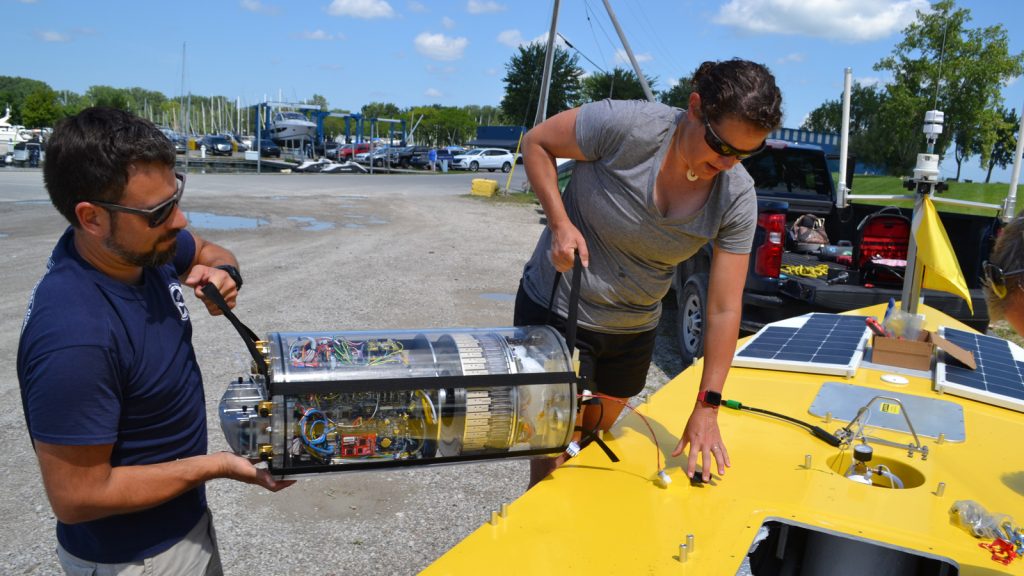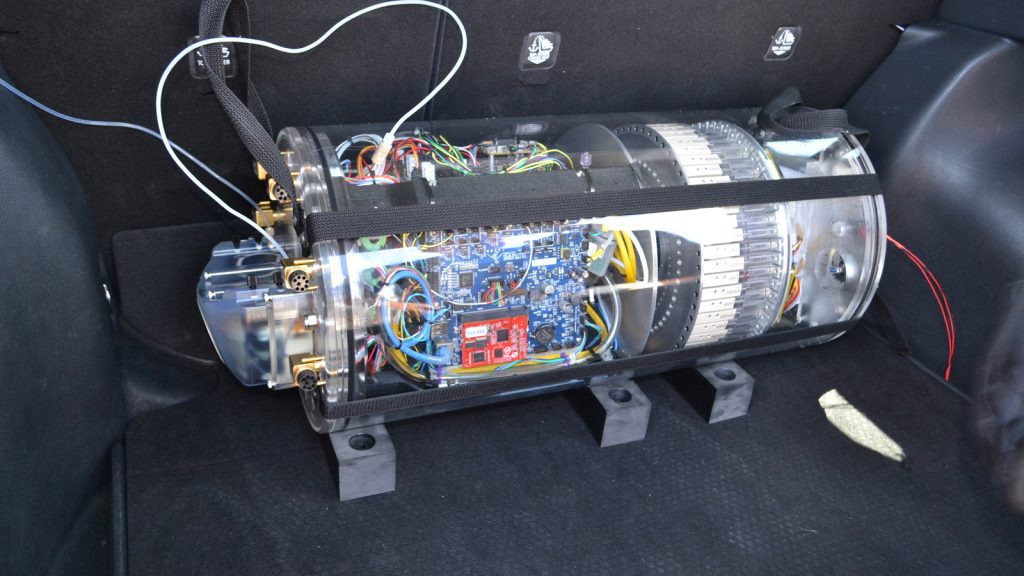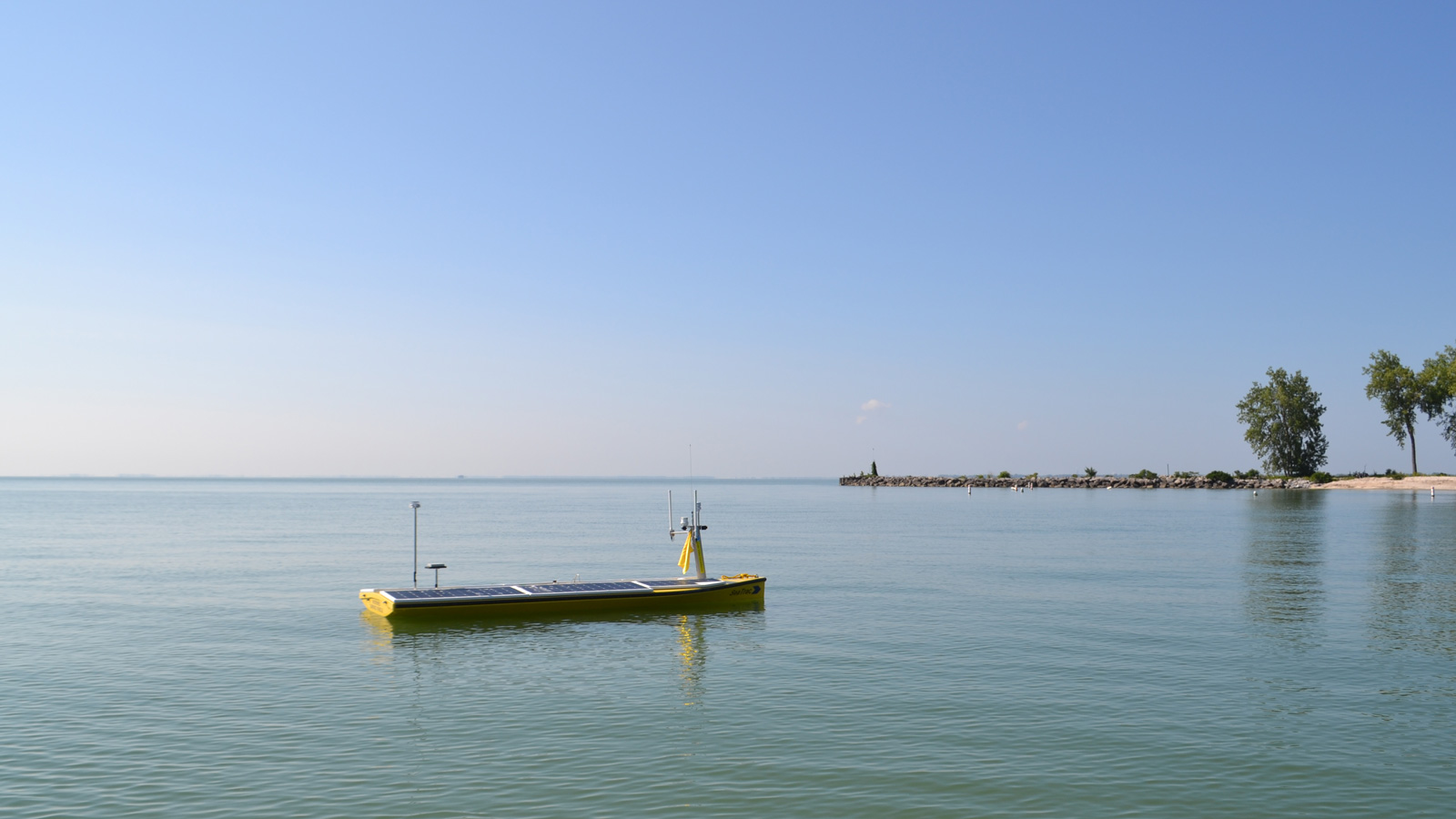For engineers and scientists, sometimes failure means progress. When developing a new technology, the process is to field test, fail, tweak, and test again, each time failing a little less and learning what does and does not work until – finally – they get it right. On August 5, 2023, scientists from NOAA’s Great Lakes Environmental Research Laboratory (GLERL), NOAA’s Atlantic Oceanographic and Meteorological Laboratory (AOML), and the Monterey Bay Aquarium Research Institute (MBARI) watched as a new solar powered surface vehicle, the SeaTrac, sailed off across the Great Lakes. For two weeks, the vessel autonomously navigated the shallow waters of western Lake Erie equipped with state-of-the-art technology, unlocking advancements in ‘omics research and our ability to monitor harmful algal blooms (HABs).

The solar-powered SeaTrac is an autonomous (self-governing) surface vehicle capable of navigating the shallow waters of western Lake Erie. photo credit: NOAA/GLERL
“Sometimes it’s gotta fail to move forward,” said Kelly Goodwin, Ph.D., an AOML scientist and chair of the NOAA ‘Omics Working Group. “You tweak it and then take it out to the field again, thinking it’s going to work. You keep trying, going back to the drawing board until it does.”
The goal was to develop a fully autonomous underwater vehicle (AUV) that could collect, process and analyze biological samples, and communicate data in near-real time, while withstanding the harsh conditions of both the open ocean and the Great Lakes. A team of engineers and scientists at MBARI along with NOAA scientists first successfully deployed a long-range AUV (LRAUV) in the California Current capable of diving hundreds of meters and collecting samples for genetic analyses. However, the shallower, more inaccessible waters of the Great Lakes proved too challenging for the LRAUV to operate, forcing the team to start from scratch and search for a vehicle better suited for shallow waters, eventually leading to this mission with the SeaTrac.
Watching the SeaTrac successfully navigate Lake Erie brought celebration. “Until you get the whole system out there on the water you don’t really know what’s going to happen; it shows how complicated the engineering process actually is,” said Goodwin.

NOAA GLERL Scientist Dr. Reagan Errera (right) and Marine Engineer Kyle Beadle removing MBARI’s 3G ESP sampling robot from the inside of the SeaTrac. photo credit: NOAA/Kelly Goodwin
While the SeaTrac differs from the LRAUV in its ability to navigate only along the water’s surface, the two autonomous vehicles share the ability to collect biological samples by housing a robot known as “the 3G ESP,” or 3rd Generation Environmental Sample Processor. The instrument was developed by MBARI to collect water samples without human intervention for ‘omics analyses. NOAA ‘omics, a growing science and technology focus area, employs fields such as metagenomics, metatranscriptomics, and proteomics to examine genetic material (DNA, RNA and proteins) from an array of species, ranging from microscopic organisms to large fish or even marine mammals.
The autonomously collected samples will be analyzed for environmental DNA (eDNA), the genetic material left by organisms in the environment. eDNA allows us to monitor and understand aquatic life, including organisms that cause HABs in the Great Lakes. The ability to collect eDNA autonomously has a variety of perks, for example, monitoring during weather conditions too dangerous for crewed missions – which the SeaTrac did indeed accomplish during this deployment. It was an example of scientific tenacity as researchers joined together to overcome barriers to unlock new capabilities for HAB monitoring and research.

Close up photo of the 3G ESP instrument developed by MBARI, which was deployed as a payload in the SeaTrac to collect and process samples for detection of eDNA and HAB toxins. Photo Credit: NOAA/ GLERL
In addition, the instrument did more than just collect and preserve samples for later analysis of eDNA in the laboratory. It also autonomously processed and analyzed samples for HAB toxin while cruising on the lake. The 3G ESP/ SeaTrac combination was equipped with a cutting-edge sensor that measured HAB toxin concentrations on-the-fly and transmitted the data to shore-based operators. Fast delivery of toxin data to resource managers will allow informed decisions regarding public health protection. This on-board processing unit was developed by scientists at MBARI and the NOAA National Centers for Coastal Ocean Science (NCCOS).
While the successful deployment of the SeaTrac with the 3G ESP equipped with a toxin sensor was a major milestone, work remains to develop and use this coupled technology on a larger scale. To this end, AOML developed a Transition Plan entitled “Advancing NOAA Autonomous ‘Omics Capabilities” that outlined the collaborative effort of AOML, GLERL, MBARI, and NCCOS. Signed by NOAA leadership in April 2023, the plan will act as a roadmap to describe how the project will mature over time with ongoing research, development, and testing. Ultimately, the strides made to advance this technology and unlock new means of performing critical environmental research demonstrate the importance of embracing risk and failing upwards.
